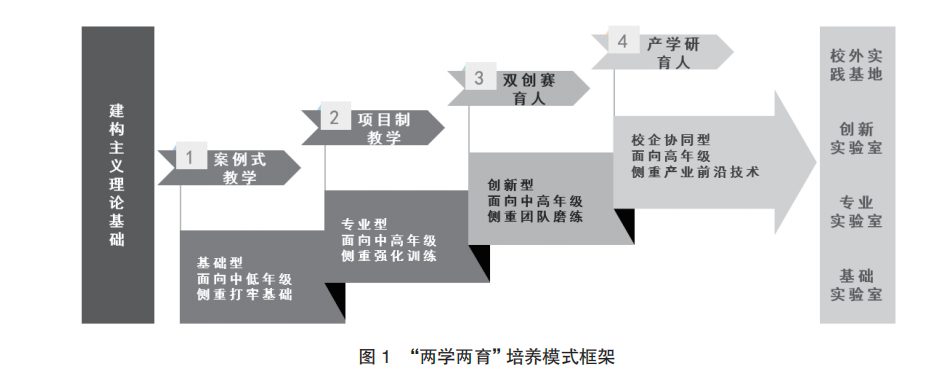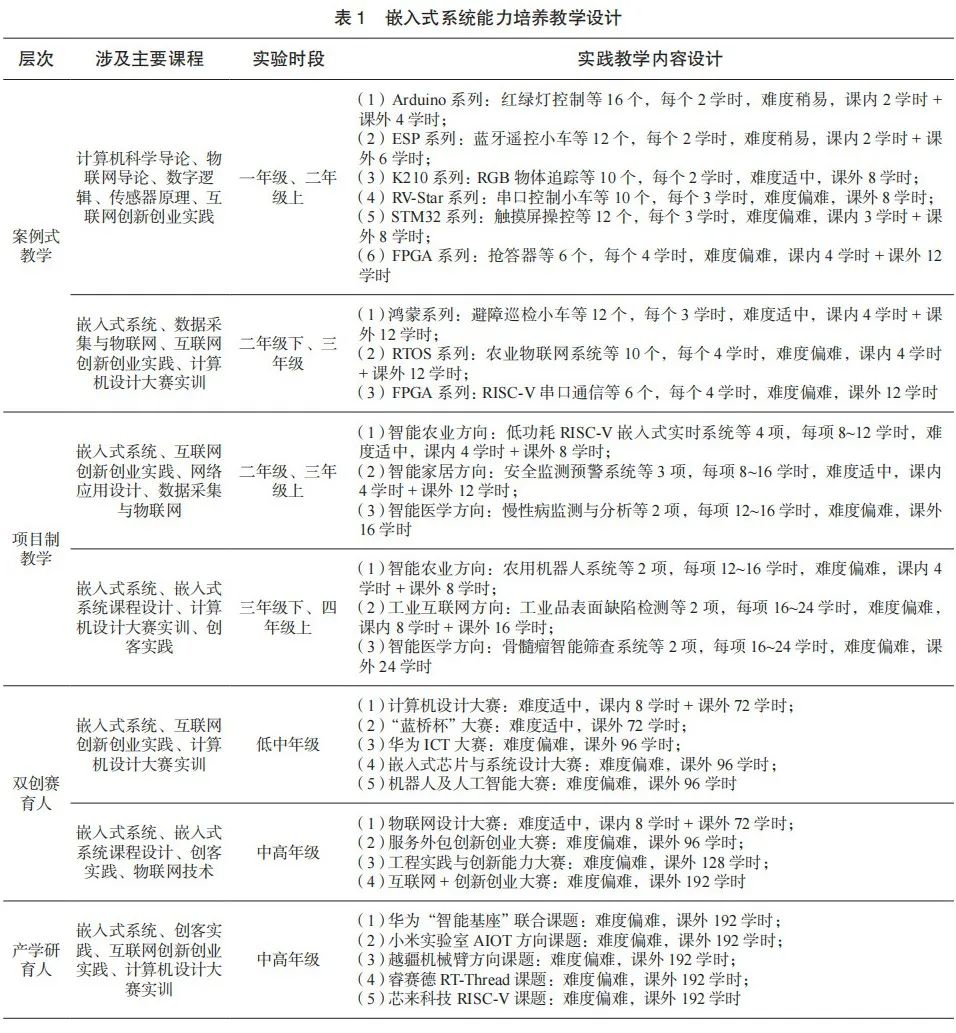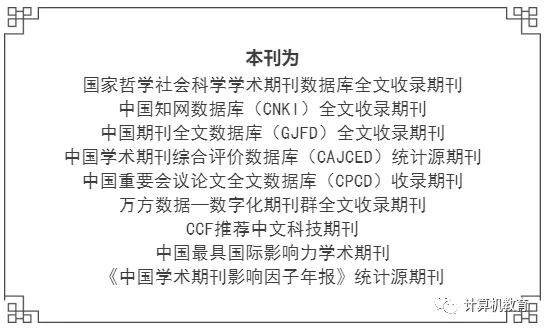0 Introduction
The teaching goal of “New Engineering” requires a “higher-order” integration of knowledge, skills, and qualities. The development status of engineering education in China is positive but faces some challenges. Embedded systems are a crucial course for engineering students, significantly impacting the cultivation of engineering talents with systemic thinking abilities and promoting the development of embedded application fields. The future talent is key. Currently, many universities lack systematic and engineering capability training in embedded systems experimental teaching, making it difficult to meet the “two characteristics and one degree” curriculum standards, which do not align with the established graduation goals, resulting in a disconnect between the practical abilities of students and industry needs.[1-2] By integrating the four-level training model of “Two Studies and Two Educations,” and strengthening the OBE educational philosophy and CDIO engineering education paradigm, the course objectives can be achieved, thereby enhancing the quality of experimental teaching and fostering high-quality innovative industrial talents.
1 Issues in Experimental Teaching
(1) Popular majors in “New Engineering” often have a large number of students from diverse regions, leading to significant differences. Embedded systems experiments mostly use relatively simple equipment like experimental boxes or boards, resulting in monotonous experimental content primarily focused on verification experiments.
(2) Computer science is an applied discipline with rapid technological updates and high engineering complexity, with a high degree of interrelation among major courses. Currently, it is challenging for the teaching staff to achieve a “course group” approach, and the construction of experimental teaching resources is often untimely, insufficient in quantity, of low quality, and lacking in cutting-edge relevance.
(3) Overall, current university students have weak interdisciplinary application abilities, generally lack innovation capabilities and critical thinking, rarely exhibit a spirit of challenge and risk-taking, and show limited initiative in asking questions and engaging in discussions. Team collaboration awareness is weak, making it difficult to fully exercise their problem-solving abilities in complex engineering issues during experiments.
2 Design of the ‘Two Studies and Two Educations’ Model
University education should extend “downward” from society, not just “upward” from high school. The objectives of university education should not only focus on the accumulation and growth of high school knowledge but also emphasize students’ adaptability and knowledge transformation capabilities after entering society. In the context of the development of “New Engineering,” exploring a four-level training model based on “Two Studies and Two Educations” can empower embedded systems experimental teaching, integrating the entire process of cultivating systemic and engineering capabilities.“Two Studies and Two Educations” refers to “case-based teaching,” “project-based teaching,” “innovation and entrepreneurship competitions for education,” and “industry-university-research integration for education.”The framework of the “Two Studies and Two Educations” training model is shown in Figure 1.

Improve the practical teaching system based on constructivist theory to implement “case-based teaching” and “project-based teaching,” integrating these into a spiral framework of teaching practice. This reflects the core of constructivist theory, connecting concepts with specific contexts to form a conceptual framework. Each concept’s teaching should cover sufficient examples, with each example potentially involving other concepts.[3] Guided by the CDIO engineering education paradigm, students can gradually build their knowledge framework in the embedded direction through “learning by doing,” forming their unique mental models, which also helps enhance their problem-solving skills and critical thinking.[4-5]
It is essential to strengthen the OBE practical education philosophy, focusing on student-centered thoughts. Through the two external directions of “innovation and entrepreneurship competitions for education” and “industry-university-research integration for education,” a comprehensive practical platform resource should be constructed using an “internal training and external introduction” approach, increasing external industry-research integration resources for students in the middle and upper grades. This allows students to connect with embedded-related industries earlier, continuously broadening their horizons at the technological forefront and clearly recognizing current societal demands and their strengths and weaknesses. This approach is more conducive to students’ personalized development, helping them adapt to or integrate into the industry more quickly and find suitable directions for future innovation and entrepreneurship.
3 Implementation Path of the ‘Two Studies and Two Educations’ Model
The specific situation of the embedded systems capability training design supported by the “Two Studies and Two Educations” model is shown in Table 1.

3.1 Integrated Online and Offline ‘Case-Based Teaching’
The core skills of computational thinking include five dimensions: creativity, critical thinking, algorithmic thinking, problem-solving, and collaborative learning.[6] Based on these principles, an integrated online and offline practical education platform is constructed, designed with open sharing and “virtual-real” integration. It includes experimental resource case libraries for remote-controlled assembly cars, obstacle-avoiding inspection cars, agricultural IoT, and intelligent networked robots, providing students with a rich, realistic, reproducible, and freely explorative experimental environment. In courses such as Introduction to Computer Science, Introduction to IoT, Embedded Systems, and Internet Innovation and Entrepreneurship Practice, we have designed a series of classic cases based on new technologies like RISC-V, AIOT, and robotics. These accumulated cases lay a solid foundation for undergraduate freshmen to reshape their mental models and computational thinking, preparing them for subsequent project-based teaching.
For example, the “HarmonyOS Obstacle-Avoiding Inspection Car” combines the HarmonyOS and RISC-V processors to build an indoor and outdoor obstacle-avoiding car with ultrasonic and positioning modules, allowing students to engage with cutting-edge industry technologies, understand the working principles of such digital systems, and experience the application scenarios and intuitive effects of new technologies.
3.2 Modular Stepwise ‘Project-Based Teaching’
Based on the growth patterns of innovative talents, a gradual and fine-grained training mechanism is designed, incorporating foundational, comprehensive, and innovative modular micro-project educational concepts throughout experimental teaching. The project-based teaching, based on the CDIO (Conceive, Design, Implement, Operate) new paradigm of engineering education, covers knowledge from multiple disciplines, including electronic information, computer science, software engineering, artificial intelligence, and cybersecurity, encompassing practical content from embedded software design, embedded systems, computer design competitions, and embedded systems course design, while opening micro-projects on themes like embedded real-time systems, logistics robots, intelligent medical assistance systems, and intelligent agriculture. For lower-grade students, the focus is on cultivating engineering awareness and engineering thinking training, while for middle and upper-grade students, the emphasis is on engineering capabilities and systematic ability training, developing a CDIO-based computer system capability training model.
Taking RISC-V embedded real-time systems as an example, students can gain an in-depth understanding of the RISC-V instruction system, learn the complete design of microprocessors, deeply understand the RTOS kernel, master the design and development processes of complete embedded systems, and achieve global perspectives, systematic views, and design thinking abilities, gradually forming their capacity to solve complex engineering problems.
3.3 Integration of Learning and Competition ‘Innovation and Entrepreneurship Competitions for Education’
Adhering to the new concept of open-source, open, and shared innovation and entrepreneurship education, we implement a practical education training program that integrates maker platforms with academic competitions, achieving a win-win situation of “promoting learning through competition, promoting teaching through competition, and promoting research through competition.” We summarize high-quality resources and implement updates to open experimental laboratory platforms based on open-source software and hardware to support academic competitions, covering various embedded-related competitions such as computer design competitions, the “Lanqiao Cup,” Huawei ICT competitions, IoT design competitions, embedded chip and system design competitions, and robotics and AI competitions. The unique products resulting from these competitions can also be transformed into experimental case resources for updating the experimental platform, serving as excellent examples for lower-grade students. Previously, students found embedded system design obscure and hard to grasp, but through this approach, the learning threshold has been lowered, students’ interest in learning has been stimulated, their personalized abilities have been enhanced, and their autonomous learning capabilities and innovative research awareness have naturally improved. This allows them to continuously enhance their “three innovation” capabilities during academic competition training, significantly boosting their core competitiveness in computer system directions.
For example, in the computer design competition, the IoT category has set up specialized IoT competitions, while the AI category has established AI challenge competitions. These competitions integrate real-world problems posed by enterprises, providing university students with various technical requirements for innovation and entrepreneurship training, allowing them to understand the actual needs and cutting-edge technologies of enterprises during their university years. Through continuous participation and practical exercises over the years, students significantly enhance the accumulation of research results and their transformation into practical applications, continuously elevating their innovative awareness.
3.4 Collaborative ‘Industry-University-Research Integration for Education’
To promote demand-oriented, multidisciplinary integrated education, strengthen inter-school exchanges, university-enterprise cooperation, and engagement in rural revitalization, we integrate and gather the advantageous resources of universities, enterprises, and local governments. By combining “going out and inviting in,” we broaden the communication channels for teachers and students both inside and outside the university, facilitating the external radiation and promotion of practical teaching and the rapid transformation of research results. We co-built the “Intelligent Base” project with Huawei, collaborated with ChipRise Technology on RISC-V technology development, and engaged with companies like Xiaomi, Ruiside, and Yuejiang Technology on AIOT system platforms for robotic arms. We also utilize alumni resources to take students into enterprises, communities, and industrial parks during summer and winter social practice, injecting new vitality into the country’s strength in science and technology and rural revitalization. These efforts have brought new ideas and perspectives to students’ experimental training, extracurricular research interests, innovation and entrepreneurship training, academic competitions, and entrepreneurial practices, broadening their horizons. Through years of practice, a replicable collaborative “Industry-University-Research Integration for Education” mechanism has gradually formed.
For instance, with Huawei’s “Intelligent Base,” the company provides students with hardware resources like Kunpeng and Ascend, as well as software resources like HarmonyOS, Euler, and Gauss. Through faculty training and teaching discussions, we jointly develop course resources and build integrated technology clubs and practice bases, giving students more opportunities to engage with cutting-edge industrial technologies, accelerating the transformation from theoretical learning to practical application, shortening the time for university students to connect with the industry, and facilitating their quicker integration into the construction of an innovative country and the development of a digital economy.
4 Analysis of Practical Outcomes
By optimizing the structure of the practical teaching team and attracting multiple forces, including graduate students, entrepreneurial alumni, and engineers from partner enterprises, we collaboratively implement the four-level training of “Two Studies and Two Educations,” adopting a tiered approach to build experimental teaching resources. The core goal is to achieve effective learning outcomes for students. Taking the experimental situation of 2022 as an example, 490 students participated in the Introduction to Computer Science experiment, 304 in the Embedded Systems experiment, 58 in Internet Innovation and Entrepreneurship practice, 365 in open experiments, 285 in competition training, and 30 in maker practice. The participation rate has significantly increased compared to previous years, and the total hours of experimental teaching have also notably increased, resulting in higher quality practical teaching and a more robust atmosphere for innovation and entrepreneurship.
By collaborating with over ten enterprises and institutions to establish engineering practice education bases containing embedded systems teaching resources, university-enterprise joint laboratories, and university-enterprise cooperative internship bases, and leveraging social practice activities for rural revitalization in Jiangxi, Henan, and Hubei provinces, we have integrated various “innovation and entrepreneurship” competitions showcased at the annual meeting of the university students’ innovation and entrepreneurship training program. We have designed nearly a hundred experimental cases and over ten experimental projects, providing innovative and entrepreneurial teaching resources for over a thousand students at our university, creating opportunities for on-campus training and off-campus internships, and also having a positive radiating effect on other peer institutions.
In the context of cultivating computational thinking and systemic and engineering capabilities under the “New Engineering” background, the “Two Studies and Two Educations” training model can achieve collaborative support for software and hardware, as well as interdisciplinary integration, gradually cultivating students’ systemic views, engineering thinking, and innovative capabilities. A number of outstanding student entrepreneurial teams such as PaiYou Programming Puzzle, Mingya Maker, Keso Technology, and Wuyou Alumni have emerged. In recent years, the scale of student participation in academic competitions involving embedded topics has significantly increased, the quality of completed projects under the innovation and entrepreneurship training program has improved year by year, and the number of approved applications for innovation credits has continuously risen. According to incomplete statistics, students have won over 50 national-level awards in competitions such as the National College Student IoT Design Competition and the National College Student Computer Design Competition, with around 300 students participating each year. These achievements are sufficient to demonstrate that the “Two Studies and Two Educations” training model has yielded certain results.
5 Conclusion
The practical teaching model of “Two Studies and Two Educations” has a broad coverage, enabling interdisciplinary exchanges among students both within and outside their majors. Its strong systemic nature means that each level is not entirely independent but mutually supportive and optimized. It can achieve a win-win situation for the country and talents, producing innovative and compound talents at the embedded systems level that society needs through four years of undergraduate training. It also provides valuable experience and quality resources for university students with entrepreneurial dreams. It has already achieved some results at our university and can be replicated and promoted in engineering education at peer institutions. Of course, the “Two Studies and Two Educations” training model still needs to be gradually adjusted and updated through longer-term teaching practice to continue developing and improving, responding to China’s strategy for a strong technological nation and adapting to societal development needs.
References:
[1] Wang Yi, Zhang Huyin, Huang Jianzhong, et al. Design of Experimental Cases Based on Human Posture Perception Information for “New Engineering”[J]. Experimental Technology and Management, 2023(3): 217-225.
[2] Fang Ying, Wang Zheng, Zhang Huyin, et al. Design of Innovative Practice Competition Cases Based on Deep Learning[J]. Computer Education, 2023(7): 123-127.
[3] Chen Hongmin, Lu Yu. Research on IT New Technology Project-Based Teaching Strategies Based on Constructivism[J]. Journal of Fujian Normal University (Philosophy and Social Sciences Edition), 2009(1): 145-149.
[4] Zha Jianzhong. On the CDIO Model under the “Learning by Doing” Strategy[J]. Higher Engineering Education Research, 2008(3): 1-6.
[5] Zhang Wenxue, Wang Sunyu, Li Wei. Research and Suggestions on Higher Engineering Education Professional Certification Standards[J]. Higher Engineering Education Research, 2006(5): 22-26.
[6] Zhou Pinghong, Niu Yukun, Wang Kang, et al. STEM Engineering Design Teaching Model and Application Aimed at Cultivating Computational Thinking[J]. Modern Distance Education Research, 2022(1): 104-112.
Fund Project: National Natural Science Foundation Project (62171325); Wuhan University Experimental Technology Project (WHU-2022-SYJS-05, WHU-2021-SYJS-12); Wuhan University Experimental Teaching Center Open Project (WHU-2021-XYKF-08).
Author Introduction: Huang Jianzhong, male, Wuhan University senior experimental engineer, research direction in embedded systems, intelligent IoT, computer systems, [email protected]; Peng Hongmei (corresponding author), female, Wuhan University experimental engineer, research direction in software engineering, IoT applications, [email protected].
Reference Format: Huang Jianzhong, Peng Hongmei, Liu Shubo, et al. Integration of ‘Two Studies and Two Educations’ in Embedded System Training[J]. Computer Education, 2024,(07):56-60.
Article Header Image Created by ‘Zhipu Qingyan’.
(End)
More Exciting:
Principal Interview|Rooted in Frontier Minority Areas, Focusing on Teacher Education to Cultivate High-Quality Application-Oriented Talents——Interview with Principal Chen Benhui of Lijiang Normal University
Yan Shi│Review and Prospect of Computer System Capability Training
Discussion on the Concept of ‘Student-Centered’ Teaching and Its Implementation Path
Principal Interview|Promoting Interdisciplinary Integration to Cultivate Innovative Talents in the New Era——Interview with Professor Ni Mingxuan, Founding President of Hong Kong University of Science and Technology (Guangzhou)
The New Year Message from the Seventh Editorial Committee
Teaching Guidelines for Ideological and Political Education in Computer Courses
Academician Chen Guoliang|Cultural Construction of Virtual Teaching and Research Room for Computer Courses
Professor Chen Daoqu of Nanjing University|Dialectics in the Learning Process
Yan Shi│Reflections and Suggestions on the ‘Predicament’ of Young Teachers in Universities
Xu Xiaofei et al.|Metaverse Education and Its Service Ecosystem
【Table of Contents】Computer Education, 2024, Issue 6
【Table of Contents】Computer Education, 2024, Issue 5
【Table of Contents】Computer Education, 2024, Issue 4
【Table of Contents】Computer Education, 2024, Issue 3
【Editorial Committee Message】Professor Li Xiaoming of Peking University: Reflections from the ‘Year of Improving Classroom Teaching’…
Professor Chen Daoqu of Nanjing University: Which is More Important: Teaching Students to Question or Teaching Students to Answer?
【Yan Shi Series】: Trends in Computer Discipline Development and Their Impact on Computer Education
Professor Li Xiaoming of Peking University: From Interesting Mathematics to Interesting Algorithms to Interesting Programming—A Path for Non-Majors to Experience Computational Thinking?
Reflections on Several Issues in Building a First-Class Computer Discipline
New Engineering and Big Data Major Construction
Other Countries’ Experiences Can Be Beneficial—Compilation of Research Articles on Computer Education at Home and Abroad

